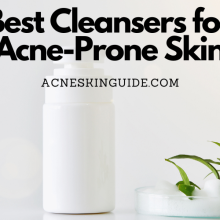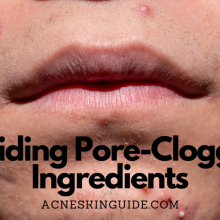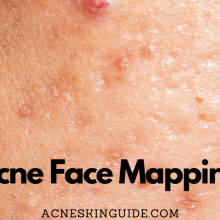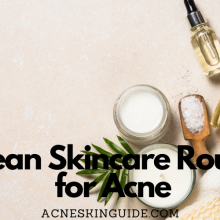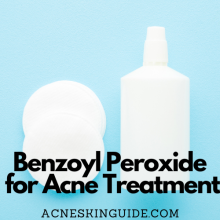Non-Comedogenic Products – What They Are and Why They Matter | AcneSkinGuide
Summary of Non-Comedogenic Products
Non-comedogenic products are specifically formulated to avoid clogging pores, making them ideal for those with acne-prone, oily, or sensitive skin. These products are assigned ratings based on their likelihood to clog pores and contain ingredients like silicones, mineral oil, and glycerin, which are effective but non-clogging.
By using non-comedogenic formulas across your entire skincare routine, you can minimize the risk of clogged pores, blackheads, and breakouts caused by product buildup. While there may be some potential downsides or myths surrounding these products, such as concerns about moisture levels or initial purging, the benefits of using non-comedogenic options far outweigh any drawbacks. With the right formulas and consistent routine, you can achieve a clear, radiant complexion by preventing clogged pores and breakouts.

Achieving Clear, Healthy Skin with Non-Comedogenic Products
For anyone who has struggled with acne, blackheads, or oily skin, finding the right skincare products can be a game-changer. Conventional products laden with pore-clogging ingredients often exacerbate existing skin concerns and lead to new breakouts. This is where non-comedogenic products come into play, offering a solution for those seeking clear, healthy skin.
What Are Non-Comedogenic Products?
The term “non-comedogenic” refers to products that are specifically formulated to not clog pores. These products are assigned ratings based on their likelihood to clog pores, with a non-comedogenic rating being the best option for preventing acne and clogged pores. They contain ingredients like silicones, mineral oil, and glycerin that are effective but don’t clog pores. Conversely, ingredients like coconut oil, cocoa butter, and lanolin are highly comedogenic and should be avoided by those with acne-prone or oily skin.
Non-comedogenic products span all types, including cleansers, moisturizers, sunscreens, and makeup. By using non-comedogenic formulas across your entire routine, you can minimize the risk of clogged pores and breakouts caused by product buildup.
The Science Behind Comedogenicity
To understand why non-comedogenic products are so important, it’s helpful to delve into the science behind comedogenicity. Pores can become clogged when there is a buildup of dead skin cells, oil, dirt, and product residue. Some ingredients are more prone to getting trapped in the pore and forming a “comedone” or plug, leading to blackheads, whiteheads, and acne.
Comedogenicity testing rates ingredients and formulas based on their pore-clogging effects. Non-comedogenic products use formulas designed to avoid this pore-clogging effect, allowing the skin to breathe and preventing the buildup that leads to breakouts.
Benefits of Non-Comedogenic Products
The primary benefit of using non-comedogenic products is the prevention of acne, blackheads, and clogged pores. By avoiding comedogenic ingredients, these formulas create less oily buildup, allowing the skin to breathe better. However, the benefits extend beyond just those with acne-prone or oily skin types.
Non-comedogenic products are suitable for all skin types, including sensitive skin, as they tend to be gentle and minimize irritation. They can also benefit various skin conditions such as rosacea and eczema by reducing inflammation and preventing further irritation from clogged pores.
Choosing the Right Non-Comedogenic Products
When shopping for non-comedogenic products, reading ingredient labels is crucial. Prioritize products with an official non-comedogenic rating over vague marketing claims like “non-pore clogging.” Look for recommended non-comedogenic options among cleansers, moisturizers, sunscreens, and makeup products based on your specific needs.
Building a Non-Comedogenic Skincare Routine
To maximize the benefits of non-comedogenic products, it’s essential to incorporate them into your entire skincare routine. Start with a pore-friendly, non-comedogenic cleanser and double cleanse to remove all makeup, sunscreen, and impurities. Follow up with non-comedogenic treatment products like serums or spot treatments to target specific concerns.
For makeup, choose non-pore clogging complexion products and use mattifying primers or powders if needed to control shine. Don’t forget to cleanse thoroughly at the end of the day to prevent product buildup.
Additionally, follow other tips to keep skin clear, such as exfoliating regularly, using clay masks to deep clean pores, and staying hydrated.
Potential Downsides and Myths
While non-comedogenic products offer numerous benefits, it’s important to address potential downsides and common myths surrounding their use.
One concern is that some non-comedogenic products may not provide enough moisture for those with dry skin types. However, this can often be addressed by incorporating hydrating serums or layering lightweight non-comedogenic moisturizers.
Another myth is that non-comedogenic products can cause purging or initial breakouts as the skin adjusts. While this can happen in some cases, it’s typically short-lived, and the long-term benefits of using non-comedogenic formulas outweigh any temporary purging.
DIY Non-Comedogenic Alternatives
For those who prefer natural or DIY skincare products, there are plenty of options for creating non-comedogenic alternatives at home. Simple recipes using ingredients like aloe vera, honey, and clay can be crafted into cleansers, moisturizers, and masks that won’t clog pores.
However, it’s important to research and avoid potentially comedogenic ingredients like coconut oil or shea butter, which are often touted as natural alternatives but can still cause issues for acne-prone skin.
Conclusion
Using non-comedogenic, non-pore clogging products is essential for achieving clear, healthy skin for all skin types and concerns. By understanding the science behind comedogenicity and incorporating non-comedogenic formulas into your routine, you can prevent clogged pores, blackheads, and breakouts.
While there may be some potential downsides or myths surrounding these products, the benefits of using non-comedogenic options far outweigh any drawbacks. With the right formulas and consistent routine, you can achieve the clear, radiant complexion you’ve been striving for.
FAQs and Answers
How long does it take to see results when using non-comedogenic products?
When switching to non-comedogenic products, it typically takes 4-8 weeks to see noticeable improvements in skin clarity and a reduction in breakouts. Here’s a general timeline of what to expect:
2-4 Weeks:
During this initial period, your skin is still purging and adjusting to the new non-pore clogging formulas. You may experience some initial breakouts as your skin rids itself of existing clogs and congestion.
4-6 Weeks:
After the 1-month mark, you should start seeing a decrease in new blackheads, whiteheads and inflamed pimples forming. Existing blemishes from the purging phase will also begin to clear.
6-8 Weeks:
By 6-8 weeks of consistent use, most people report significantly clearer skin with far fewer new breakouts. Clogged pores, excess oil, and acne should be visibly reduced at this stage if the products are effectively non-comedogenic for your skin.
It’s important to be patient and stick with the new routine, as it can take a full skin cycle (4-8 weeks) to push out all the existing pore blockages and see maximum benefits. Results may be even quicker for those with milder acne or blackhead concerns. Consistent use is key for non-comedogenic products to really improve your skin over time.
Are non-comedogenic products more expensive than regular products?
Generally speaking, non-comedogenic products tend to be slightly more expensive than regular cosmetic and skincare products that don’t make such claims. There are a few reasons for this:
- Higher quality ingredients
Non-comedogenic formulas avoid the use of cheaper pore-clogging ingredients like coconut oil, cocoa butter, etc. Instead, they rely on more expensive non-acnegenic plant oils, esters, and silicones that are less likely to clog pores. - More rigorous testing
For a product to be legitimately non-comedogenic, it requires extra comedogenicity testing beyond basic safety assessments. This additional clinical testing drives up research and development costs. - Targeted towards specialized concerns
Since non-comedogenic products are targeted towards those with acne, oily skin, and sensitivity issues, they are considered more niche or specialized products. Specialty products generally command higher price premiums.
However, the difference in cost is usually modest – you can expect to pay 10-30% more for non-comedogenic options versus regular products in many cases. For affordable drugstore brands, the difference may only be a few dollars.
That said, there are also plenty of non-comedogenic options at standard price points, especially for basic products like cleansers and moisturizers. Higher-end brands do tend to charge super premium prices for their non-comedogenic makeup and treatments.
So in summary – yes, they are typically a bit pricier, but the extent depends on the specific product category and brand. But the benefits of clearer pore-friendly skin makes it worthwhile for many.
Can non-comedogenic products be used during pregnancy or breastfeeding?
Yes, non-comedogenic products are generally considered safe to use during pregnancy and breastfeeding. Here are a few key points about using these products when expecting or nursing:
Ingredients in Non-Comedogenic Formulas:
The ingredients typically found in non-comedogenic skincare and makeup products, such as mineral oil, silicones, glycerin, and plant-based oils/butters, are non-irritating and considered low-risk during pregnancy and breastfeeding when used externally on the skin.
Avoid Certain Ingredients:
However, it’s still recommended to avoid retinoids, salicylic acid, and other harsher acne ingredients in non-comedogenic products when pregnant or nursing as a precaution, as they can potentially cause issues.
Non-Comedogenic is Preferable:
Since many women experience increased oiliness, acne flare-ups, and sensitivity during pregnancy, using non-comedogenic formulas can actually be preferable. They are less likely to clog pores and exacerbate hormone-induced breakouts.
Patch Test First:
As with any new product during pregnancy or breastfeeding, it’s wise to patch test non-comedogenic items first before applying all over, just to check for any personal sensitivities or reactions.
Consult Your Doctor:
If you have any specific skin conditions or are concerned about particular product ingredients, don’t hesitate to consult your OB/GYN or dermatologist about which non-comedogenic brands are best.
Overall, non-comedogenic skincare and makeup are considered a safe and smart choice for maintaining clear pores and an even complexion during the physical changes of pregnancy and nursing.
Do non-comedogenic products reduce the appearance of existing acne scars?
Non-comedogenic products are not specifically formulated to reduce the appearance of existing acne scars. However, they can indirectly help improve the look of acne scars over time in a few ways:
- Prevent Further Scarring
By avoiding pore-clogging ingredients, non-comedogenic products help stop new breakouts from occurring. This prevents the acne inflammation that can lead to additional scarring and post-inflammatory hyperpigmentation. - Allow Skin to Renew Faster
Since non-comedogenic formulas don’t clog pores, they allow the skin to shed dead skin cells and regenerate new skin more efficiently. This speeds up the skin’s natural renewal process to soften the appearance of scars gradually. - Reduce Redness/Pigmentation
Many non-comedogenic products contain calming ingredients like niacinamide that can help reduce the redness and post-acne dark marks that accentuate the look of scarring initially. - Increase Product Absorption
The non-clogging nature of these products may allow better absorption of any additional scar treatment products you use, increasing their efficacy over time.
However, to actively diminish the textural issues and depressed areas of acne scarring, more is usually needed beyond non-comedogenic products alone. Additional treatments like retinol, vitamin C, AHAs, derma-rolling, laser, or procedures may be required to see significant fading of scars.
But by using non-comedogenic formulas as a base, you can prevent new acne scars while optimizing overall skin regeneration to gradually minimize the appearance of older acne scarring in conjunction with targeted scar treatments.
What are some tips for transitioning to a fully non-comedogenic routine?
Transitioning to a fully non-comedogenic skincare routine can take some adjustment, but these tips can help make the process smoother:
- Go slowly
Rather than overhauling your entire routine at once, phase out comedogenic products one by one and replace with non-comedogenic versions. This allows your skin to adjust gradually. - Patch test new products
Before applying new non-comedogenic items all over, do a patch test to check for any irritation or reactions first, especially if you have sensitive skin. - Remove makeup thoroughly
Since non-comedogenic makeup is designed not to clog pores, be diligent about removing it fully with a proper oil/balm/micellar cleanser to prevent any residue buildup. - Exfoliate regularly
Non-comedogenic routines pair well with gentle chemical exfoliants or exfoliating tools to keep pores clear of dead skin cells and product residue. - Expect some purging
Don’t panic if you experience some breakouts initially – this is often a normal “purging” phase as existing clogs get pushed out. - Simplify your routine
Stick to a basic cleanser, moisturizer, SPF routine while transitioning to ensure you isolate any potential pore-cloggers. Slowly add products back. - Be patient
It can take 6-8 weeks to see full results from the non-comedogenic products. Stick with it through the adjustment period. - Check product reviews
Research products by ingredients and look for reviews from those with acne-prone skin to find the most effective non-comedogenic formulas.
With some preparation and persistence, transitioning to a non-pore-clogging routine will allow you to reap all the clarifying benefits. Listen to your skin and adjust as needed.

